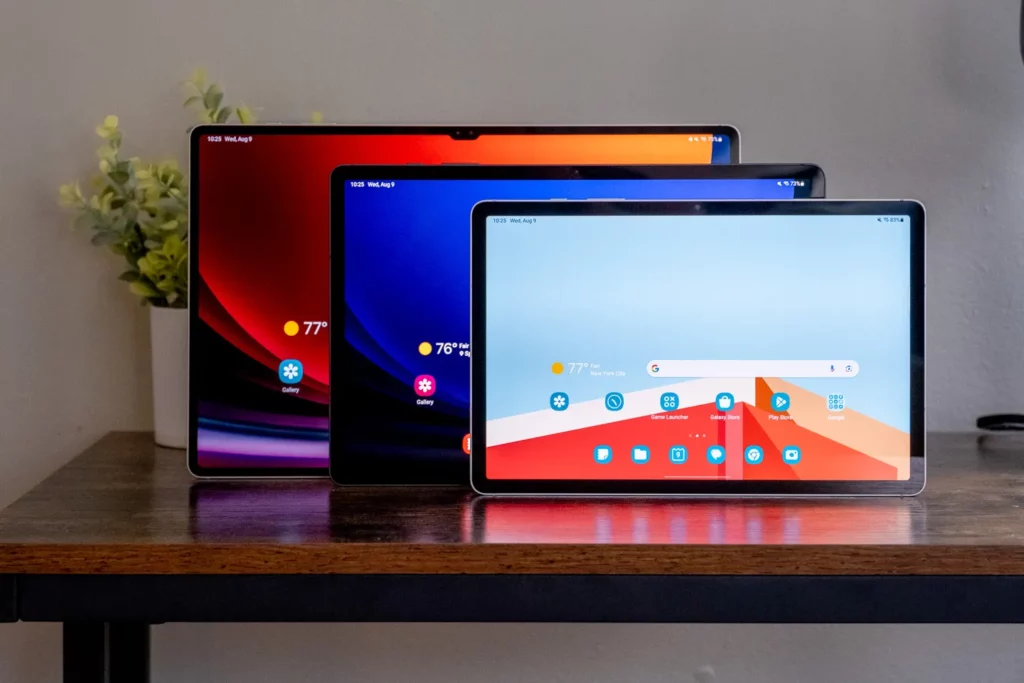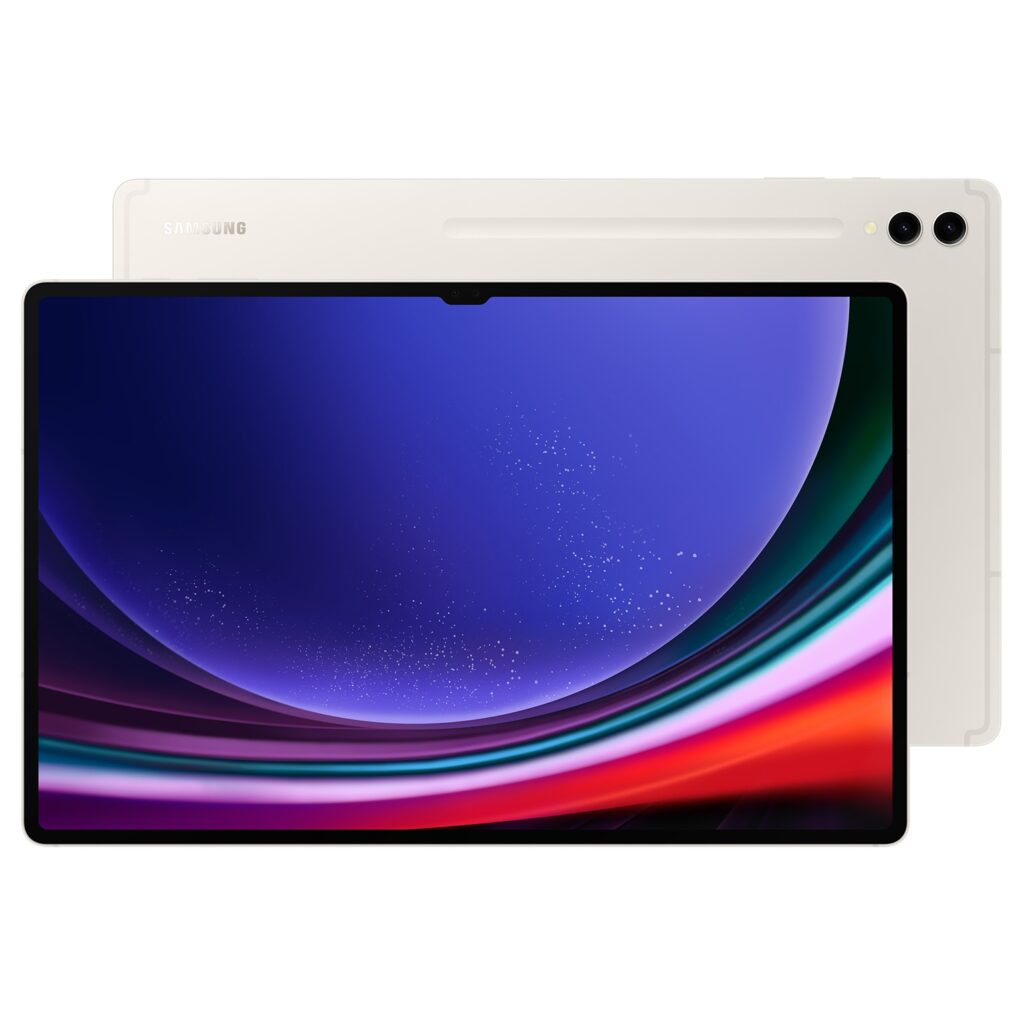The top tablets from Samsung Galaxy Tab S9 Ultra 5G are more alike than ever and include water resistance this year. Here is a guide to help you pick the ideal model.

The choice between this year’s Galaxy Tab S9 tablets, which come in three sizes—11-inch Tab S9, 12.4-inch Tab S9 Plus, and the enormous 14.6-inch Tab S9 Ultra—can be entirely based on your budget and preferred screen size. The majority of its characteristics are similar across the board, including screen technology, CPUs, color selections, designs, and accessory options.
There are two noticeable improvements in the Tab S9s over the Tab S8 lineup from a year ago: an updated Qualcomm processor that promises to be a little faster (although speed and performance were never really issues in last year’s tablets), and IP68 water and dust resistance, similar to most contemporary smartphones. As a result, you may use these pills near a pool or bathtub, or more likely, you won’t have to worry about daily hiccups in the coffee shop or when a child shocks you with their sippy bottle-throwing range. It’s a valid distinction for Samsung’s devices and a wonderful feature to have as I’m not aware of any other non-rugged tablets, whether they run Android, iPad, or something else.
None of the iPad variants are water resistant, however, all three Samsung Galaxy Tab S9 Ultra 5G
If you are reading this, I’m going to assume that you already know why you want to buy a Samsung tablet, but just in case, they are great alternatives to Apple’s iPad series if you already have a phone, earphones, or other Samsung gadget. You can quickly transfer files across devices, reply to text messages from your tablet, or utilize the same applications on both thanks to the fact that they run on the same software as phones. Depending on whatever device you’re using, Galaxy Buds can effortlessly switch between connecting to your phone and tablet. I go into more detail about it in my review of the Tab S8 and S8 Plus from the previous year, but it’s all very similar to how an iPad works with an iPhone, AirPods, and the rest of Apple’s ecosystem.
Samsung’s premium tablets, which have magnificent OLED panels and top-notch speakers, are also superb media viewing devices. Games, movies, and TV shows all look and sound fantastic on them. You couldn’t do much better than these tablets if all you want to do with them is watch movies, but if that’s all you want, you can get almost the same experience from Apple, Lenovo, or OnePlus for a lot less money.

This year, Samsung increased the price of each model by $100, so the entry-level Tab S9 starts at $799.99, the midrange Tab S9 Plus is priced from $999.99 and above, and the expensive Tab S9 Ultra starts at $1,199.99. The S Pen stylus, which is now also water-resistant, is still included with each one, but keyboards and other add-ons may quickly raise the price by several hundred dollars. Furthermore, it is disappointing that Samsung doesn’t provide a charging brick for these devices, which enable up to 45W fast charging yet take an eternity to charge with a standard phone-size charger.
I have recommendations for who each model is for after testing all three for a few weeks. For each size, I’ve also provided several price-competitive options below.
Design & Aesthetics: A Closer Look
The 11-inch Galaxy Tab S9 is the size out of the three that works best for standard tablet tasks. I’m referring to activities like watching videos, reading books, taking notes, playing games, and light work like emailing. Due to its smaller size, it is the only one of the three that you can use in portrait mode without finding it very uncomfortable to hold in your hands for a lengthy amount of time.
The Display: Beyond the Pixels
My primary issue with the Tab S9 is that Samsung insisted on maintaining the 16:10 aspect ratio, which makes the tablet much more rectangular than devices like the OnePlus Pad or an 11-inch iPad Pro. The Tab S9 is almost the same width as other tablets, but you lose at least half an inch of screen height, making web browsing seem more constrained in landscape and a little too small in portrait.
The Samsung Tab S9 has a variety of split-screen settings, and you can even use its desktop-like DeX mode to multitask. However, the lower screen size makes this somewhat cumbersome unless you keep to simple side-by-side apps. It’s not the tablet I’d pick if I wanted to perform a lot of productive work or replace a laptop.
Stylus & Accessories: Boosting Productivity
Additionally, I particularly appreciate this size for using the S Pen, my preferred pen, to take handwritten notes. The tablet comes with Samsung Notes, a feature-rich note-taking tool that syncs with Microsoft’s OneNote. The Android environment is also gradually gaining more of the options we’re accustomed to seeing on the iPad. In addition to Nebo, a longtime iPad note-taking favorite, Goodnotes, which offers superb handwriting-to-text conversion and cross-platform synchronization, is free for one year on the Tab S9 series.
Conclusion: The Future of Samsung Tablets
The huge Tab S9 Ultra should only be taken into account if you want to use it in place of a laptop to complete your task. a necessitates combining it with a keyboard cover, the price of which would increase further for an already pricey tablet. Samsung offers choices with ($350) and without ($200) trackpads. You’re looking at the cost of a properly furnished MacBook Air, which ranges from $1,400 to $1,500.
If you do commit to using this tablet, you might be surprised at how much it can accomplish. All of this is made possible by Samsung’s DeX feature, which emulates a desktop environment with free-form windows akin to those seen on Windows or macOS while running Android.

Compared to Apple’s Stage Manager feature on the iPad, DeX feels unchained. I am free to open as many windows as I want, put them anywhere I want, and make them any size I want. I can work while running many internet tabs, multiple Google Docs windows, and background activities like playing music or watching videos. I have trackpad movements, mouse support, and keyboard shortcuts (but not enough of them or in enough programs). I can still use the tablet’s display while plugging it into a bigger screen to expand everything.
The 14.6-inch display on the Tab S9 Ultra is larger than the majority of laptop screens—and it also looks better. I can spread out my work because of its generous size and don’t have to juggle windows and programs all the time. The majority of Google’s programs, the built-in apps from Samsung, and Microsoft’s Office package all make effective use of the bigger screen size with tailored layouts and functionality. Other programs, like Slack, Threads, and, to be honest, the majority of Android apps, which appear ridiculous on tablets because they aren’t designed for the larger screen, work well in limited windows in DeX since they can only utilize their phone-size layouts.
However, the Tab S9 Ultra is terrible for the majority of other tablet activities. It’s hard to place on an aircraft tray table or even some smaller bags due to its size, and it’s too heavy and large to carry in my hands for a lengthy amount of time. When I want to read a book or article, it’s awkward to hold in portrait orientation and just Too Much. Additionally, when I use it to take handwritten notes during a meeting, it takes up too much space on my desk.
The Tab S9 Ultra often gives off the impression of having an identity problem. Does it want to be a fantastic tablet for media and entertainment? Or does it want to be a deadly productivity tool? Samsung still needs to do more work before it can fully assume that position, but I believe it should tilt toward the latter.



